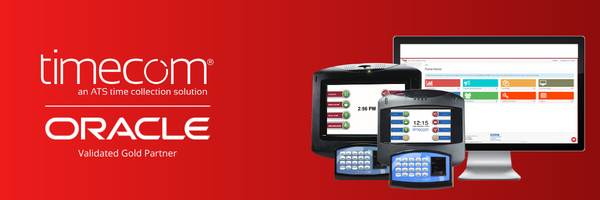When employees engage in 'time theft,' or stealing company time, it can have a detrimental impact on your company's bottom line.
With nearly half of hourly employees engaging in some type of time theft, this constitutes a significant loss. The American Payroll Association estimates that companies lose as much as 7% of their yearly payroll when employees commit time theft.
First, to prevent time theft effectively, start by recognizing that it could be causing your company to spend too much on payroll.
The second step is to bring in technology like Oracle Time and labor and integrate it with a time clock system like TimeCom. Combined, they give you valuable tools to prevent and identify employee time theft.
How you use your time clocks determines how effectively they help you minimize paying for time not worked. Here are seven best practices that will help you minimize different forms of time theft and improve employee productivity.
#1 Use Physical Time Clocks
Eliminate manual timekeeping practices in your company. Implementing an automatic time clock system prevents employees from manipulating their time sheets by adding extra minutes to their shifts.
While web-based time clocks offer advantages over manual record keeping, they may not be as effective in curbing time theft as physical time clocks. These digital systems allow employees to clock in and out from anywhere with an Internet connection, making it easier for them to punch in or out on behalf of their colleagues. Sharing login credentials can enable one employee to clock in or out for another.
To significantly reduce time theft, consider integrating time tracking software like Oracle Time and labor with a physical time clock. This combined approach enhances your time management efforts.

#2 Go Biometric
To completely stop time theft, a biometric time clock is your best bet. When you incorporate biometric time clocks into your attendance system, it becomes almost impossible for employees to engage in buddy punching or falsifying timesheets.
It is important to note that biometric systems do require additional workflows or employee adjustments. However, their unmatched ability to virtually eliminate time theft makes biometric scanners on time clocks a smart cost-saving choice.
Integrating TimeCom into your Oracle time and attendance system makes it easy to add a biometric time clock into your environment. The PeoplePoint time clock, built to work with TimeCom and Oracle, has a biometric option that's proven to eliminate buddy punching and reduce payroll bloat.
#4 Analyze Your Time Clock Data
The time clock data is not just for calculating payroll. Another great advantage to using a time clock to collect employee attendance information is the database it creates. Your workforce management system can analyze this data for several reasons, including finding instances of employees committing time theft.
Generate reports that help managers and payroll identify suspicious activities that may indicate time theft or payroll fraud. Here are some anomaly patterns your reporting can find:
- An employee whose hours are consistently higher than the rest of the shifts.
- Two people who consistently punch in and out within seconds of each other.
- An employee with consistently low productivity may be taking extended breaks.
Look for the red flags in your employee hours reporting. With an integrated time and attendance system, you can easily obtain insight and access to employee punch data. You should also be able to easily create custom reports to identify unusual patterns.
#4 Be Upfront about Your Company’s Time Theft Policy
Prevention is far less costly than remediation. Your company should communicate its policy on handling suspected and confirmed cases of workforce time theft to all employees. Include time theft awareness as part of new employee orientation.
Remind employees regularly through HR or other internal communication channels. Create a brief slide deck on the company portal to explain what counts as time theft and what does not.
#5 Adjust Your Time Clocks for Accurate Punch Times
The Fair Labor Standards Act (FLSA) does allow employers to round time, subject to certain restrictions. This includes time collected at a time clock. However, the rounding cannot:
- extended past the nearest quarter-hour increment
- primarily or always benefit the employer
More importantly, complying with these rounding restrictions does not provide certain protection in an employer in a wage and hour suit. A company is not guaranteed protection because it has a neutral rounding policy.
Not rounding time punches is a way to be fair and show goodwill to employees. One cause of time theft is the feeling employees have that their employer is stealing time from them.
Make it clear that there is no back-office manipulation of employees’ time. Indeed, one court noted in an FLSA case that “advances in electronic recordkeeping make it easy for employers to audit rounding procedures to ensure employees are paid for all hours worked.” You can eliminate one major cause of time theft by being transparent and honest with your employees.
#6 Let Your Time Clocks Enforce Meal and Rest Breaks
Even with physical time clocks, some employees working will try to steal time. They might clock in a bit early for a shift, or clock out late at the end of shift.
Employees might also try this at break time too. An employee could take their full lunch break time, but clock in early. Another common scenario is the employee who takes a smoke break but does not clock in or out at all.
Advanced time clock systems can be configured to prevent employees from clocking in or out during unscheduled breaks. Some time clocks will also have the ability for managers to override in real time and allow the off-schedule clock punch.
Some time clocks cannot stop employees from clocking in early or late for breaks. At the very least, it should be able to show a message reminding them that their entire break time is unpaid.
Getting Ahead of Time Theft with the Right Tools
If your company is not preemptively minimizing time theft, your payroll is too high. Your company can minimize time theft with the right tools used the right way.
Integrating Oracle Time Keeping with a smart time clock system saves money and boosts productivity by managing workforce efficiently.
You can learn about the different types of time clocks available and how you can use them to help your company avoid the high costs of time theft by contacting one of our solution consultants today.





